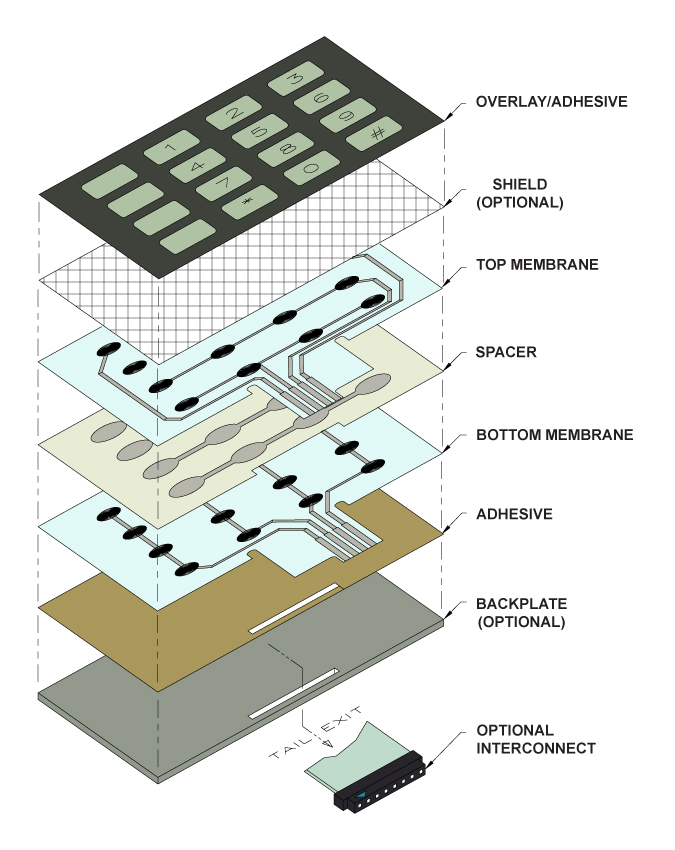Understanding the Performance of Membrane Switches Over for Interface Instruments
The performance of membrane layer switches represents a substantial development in user interface style, incorporating efficiency with aesthetic versatility. As industries significantly focus on individual experience, comprehending the nuances of membrane button technology becomes necessary.
What Are Membrane Switches?
Membrane buttons are cutting-edge user interface tools that assist in individual communication with electronic equipment. These versatile components are composed of numerous layers, consisting of a graphic overlay, spacer, and a printed circuit layer. The design enables a seamless integration into various electronic tools, improving both the visual and functional elements of interface.
Membrane switches are typically used in a wide variety of applications, from home appliances to commercial equipment and clinical gadgets. Their construction commonly features a thin account, making them a suitable choice for compact designs. The responsive responses supplied by these switches can be crafted to satisfy details individual choices, ensuring effective communication in between the customer and the tool.
Longevity is an additional significant benefit of membrane buttons, as they are resistant to dirt, moisture, and chemicals, which boosts their life expectancy sought after settings. Additionally, these buttons can be tailored in terms of form, size, and graphic layout, enabling for branding and user-specific features. On the whole, membrane layer switches represent a sensible service for improving customer experience in electronic devices, integrating capability with aesthetic appeal in a reliable manner.
Exactly How Membrane Layer Changes Work
Operating on an uncomplicated principle, membrane layer switches utilize a layered building to register user input efficiently. Each switch includes several layers, including a printed circuit layer, a spacer layer, and a top visuals layer, which are created to interact flawlessly. When a user presses the top layer, it compresses the spacer layer, bringing the conductive components of the circuit layer into contact with each various other.
This call produces a shut circuit, indicating the gadget to implement a details function. The style enables for different configurations, consisting of responsive responses, which can boost the customer experience by offering a physical feeling upon activation. The products utilized in membrane switches usually include flexible substrates, such as polyester or polycarbonate, which make sure toughness and strength versus deterioration.

Key Benefits of Membrane Layer Buttons

One more significant advantage is their density. Membrane layer switches are slim and lightweight, which makes it possible for producers to conserve space in their gadgets without giving up capability. This attribute is especially useful in applications where weight and volume are essential factors to consider.
Furthermore, membrane buttons are resistant to dirt, wetness, and chemicals, enhancing their durability. This resilience extends their life-span and minimizes the requirement for frequent replacements, causing expense financial savings in time.
In addition, the tactile comments provided by membrane layer buttons can be enhanced to boost individual communication. They can consist of attributes such as raised buttons or distinct clicks, boosting use and individual experience.
Applications Throughout Industries
User interface tools utilizing membrane buttons are common in a vast selection of markets, showcasing their flexibility and functionality. Membrane Switch. In the medical industry, membrane switches are essential to devices such as analysis tools and patient monitoring systems, where their resilience and convenience of cleaning are essential for keeping health criteria. In the auto sector, these buttons are used in control panel controls and infomercial systems, supplying a streamlined and modern-day user interface for individuals.
Furthermore, the consumer electronics sector her latest blog gain from membrane layer buttons in appliances and portable tools, where small style and easy to use interfaces boost customer experience. Industrial applications additionally utilize membrane changes for control panels in machinery and automation systems, stressing their effectiveness and resistance to extreme atmospheres.
In the aerospace and protection markets, membrane switches are made use of in cockpit controls and tools, where integrity and efficiency under severe conditions are paramount. Additionally, the pc gaming industry increasingly incorporates membrane switches in controllers and gallery makers, contributing to an interesting individual experience. On the whole, the adaptability of membrane switches over allows their widespread usage across countless markets, highlighting their significance in modern-day interface design.
Future Fads in Membrane Switch Over Technology

Furthermore, the usage of innovative materials, such as polycarbonate and polyester films, is expected visit this site to climb, providing enhanced toughness and resistance to ecological stress factors. These materials add to the general useful source long life of membrane switches, making them appropriate for harsher industrial applications.
Moreover, the incorporation of wise technology, consisting of IoT connection, will certainly enable membrane buttons to connect with various other devices and systems, helping with a much more interactive customer experience. This fad straightens with the expanding need for clever tools throughout different markets, from health care to customer electronics.
Finally, customization alternatives are prepared for to increase, enabling manufacturers to produce bespoke services tailored to specific customer demands and choices. These advancements will position membrane layer buttons as crucial parts in the evolution of user interface modern technology.
Verdict
In verdict, membrane layer changes stand for an essential innovation in customer interface technology, using a reliable and versatile remedy for varied electronic applications. Their split building assists in compact layout, while functions such as tactile responses boost individual interaction. The durability versus ecological elements further strengthens their utility throughout numerous markets. As advancements in product scientific research and touch picking up innovations continue, the performance and applicability of membrane buttons are expected to increase, reinforcing their value in modern digital devices.